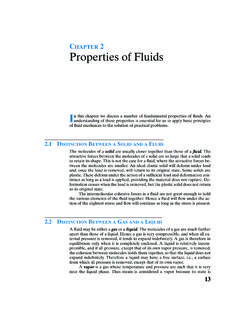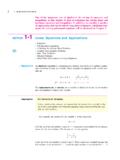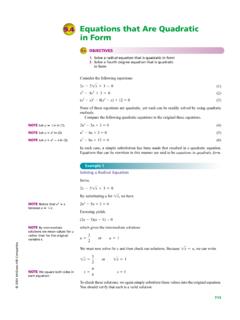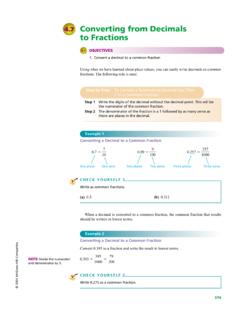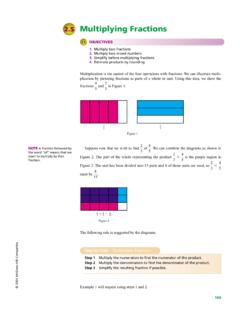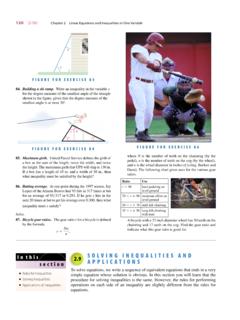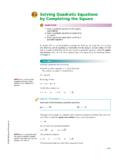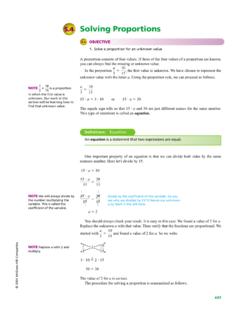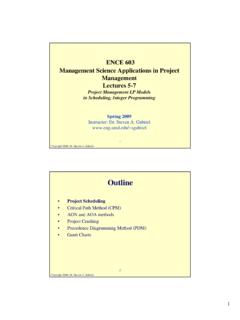Transcription of 7.6 Applications of Rational Equations - McGraw Hill …
1 Applications of Rational Equations OBJECTIVES. 1. Solve a literal equation that involves a Rational expression 2. Solve a distance problem that involves a Rational equation 3. Solve a work problem 4. Convert units In the previous section, we solved Rational Equations . In this section we will see several Applications of those techniques. Given a literal equation such as 1 1 1.. R R1 R2. we can use the techniques of Section to solve for one of the variables. Example 1. Solving a Literal Equation R1. NOTE This is a parallel electric circuit. The symbol for a resistor is.
2 R2. NOTE Recall that the numbers If two resistors with resistances R1 and R2 are connected in parallel, the combined resis- 1 and 2 are subscripts. We read tance R can be found from R1 as R sub 1 and R2 as R. sub 2. 1 1 1.. R R1 R2. Solve the formula for R. First, the LCD is RR1R2, and we multiply: 2001 McGraw -Hill Companies 1 1 1. RR1R2 RR1R2 RR1R2 . R R1 R2. Simplifying yields R1R2 RR2 RR1 Factor out R on the right. NOTE Reversing the left and R1R2 R(R2 R1) Divide by R2 R1 to isolate R. right sides of an equation uses R1R2 R1R2. the symmetric property of R or R.
3 Equality. R2 R1 R1 R2. 545. 546 CHAPTER 7 Rational EXPRESSIONS AND FUNCTIONS. CHECK YOURSELF 1. Solve for D1. NOTE This formula involves 1 1 1. the focal length of a convex . F D1 D2. lens. Many distance problems also lead to Rational Equations . You will recall that distance (d), rate (r), and time (t) are related by the following formula Rules and Properties: The Distance Relationship I. d r t Treating this as a literal equation, we can produce two variations that frequently lead to Rational Equations . Rules and Properties: The Distance Relationship II. d r.
4 T and Rules and Properties: The Distance Relationship III. d t . r Example 2. Finding a Rate A boat, which moves at 36 mi/h in still water, travels 28 mi downstream in the same amount of time that it takes to travel 20 mi upstream. Find the speed of the current. 2001 McGraw -Hill Companies 36 mi h rate of current Applications OF Rational Equations SECTION 547. When solving an application that involves the distance relationship, it is usually best to begin by completing the following table. Distance Rate Time Upstream Downstream Letting r represent the rate of the current, we have the following information: Distance Rate Time Upstream 20 36 r Downstream 28 36 r Using relationship III above, we can complete the last column of the table.
5 Distance Rate Time 20. Upstream 20 36 r (36 r). 28. Downstream 28 36 r (36 r). Having completed the table, we go back to the original problem. The key phrase is in the same amount of time. That means that the time going upstream is the same as the time going downstream. This leads to the equation 28 20.. (36 r) (36 r). The LCD is (36 r)(36 r). Clearing the fractions, we get 28(36 r) 20(36 r). 1008 28r 720 20r 288 48r r 6. The rate of the current is 6 mi/h. 2001 McGraw -Hill Companies CHECK YOURSELF 2. A boat, which moves at 30 mi/h in still water, travels 3 mi downstream in the same amount of time that it takes to travel 2 mi upstream.
6 Find the speed of the current. Another type of application that frequently leads to a Rational equation is something called a work problem. Solving a work problem is simplified by using the following work principles. 548 CHAPTER 7 Rational EXPRESSIONS AND FUNCTIONS. Rules and Properties: Work Principle I. If a job takes t hours to complete, then, for each hour, 1. t represents the portion of the job that has been completed. 1. This principle confirms that, if a job takes 2 h to do, then of the job is done each hour. If 1 2. a job takes 10 h to do, then of the job is done each hour.
7 10. Extending the idea behind the first principle, we find the second work principle. Rules and Properties: Work Principle II. If two entities are working on the same job, and the first would take a hours to complete the job alone and the second b hours to complete the job alone, then the expression 1 1.. a b represents the portion of the job completed each hour if both entities are at work. Combining these two principles, we get an equation that will allow us to find the total time it takes to complete a job. Rules and Properties: Work Principle III. If two entities are working on the same job, and the first would take a hours to complete the job alone and the second b hours to complete the job alone, then the equation 1 1 1.
8 A b t can be used to find t, the time it will take to complete the job. 2001 McGraw -Hill Companies We will use this equation in the next example. Example 3. Solving a Work Problem Jason and Hilger are required to paint over the graffiti on a wall. If Jason worked alone, it would take him 20 h to repaint. Working alone, Hilger could do the job in 15 h. How long will it take them to do the painting if they work together? Applications OF Rational Equations SECTION 549. Using the work principle, we get the equation 1 1 1.. 20 15 t Clearing the fractions (LCD 60t) yields 3t 4t 60.
9 7t 60. 60. t . 7. 4. Working together, they will finish the job in 8 h. Note that, when working together, it will 7. always take less time to complete a job than it will take either individual! CHECK YOURSELF 3. Filling a hot tub with a hose will take 4 h. Draining the same tub takes 7 h. If the drain is open, how long will it take to fill the tub? (Hint: Treat the draining time as a negative number.). The techniques used with Rational Equations are also used when performing unit conver- sions. The following table contains some of the common conversion factors.
10 Common Conversion Factors 1 mile 5280 feet 1 hour 60 minutes 1 minute 60 seconds 2001 McGraw -Hill Companies 1 kilogram 1000 grams 1 second 1,000,000 microseconds 1 gigabyte 1,000,000,000 bytes Each of the conversion factors can be rewritten as one of two fractions that are equal to one. For example, we can rewrite the statement 1 kilogram 1000 grams as either 1 kilogram 1000 grams 1 or 1. 1000 grams 1 kilogram 550 CHAPTER 7 Rational EXPRESSIONS AND FUNCTIONS. Example 4. Converting Units An SST can fly over 2000 mi/h. To the nearest tenth, how many miles does it cover each second?

